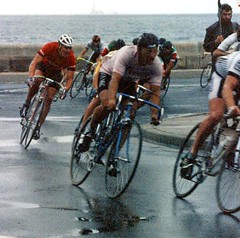bike racing: the penultimate guide: Bike racing 101 - part 2 - goal setting

Bike racing 101 - part 2 - goal setting
Last time I set the scene. (Usual disclaimer applies about starting any exercise program slowly, checking with a doctor first and so on.) In brief, I outlined my personal approach. Go riding, enjoy it and find some buddies to encourage you. Then leverage that fitness and skill to start racing. Of course there's lots more to it than that.
For instance, what are your goals? Ask yourself why am I doing this? Is it that you want to stay fit and healthy in the long term, and to get out there riding regularly you need extra motivation? Or is it to simply try out racing, just because you'd like to? Try to understand why you want to do it and feed off that motivation. Remind yourself why on those hard days when you question the whole idea. And review your goals regularly. You may want to find out how good you could be, given whatever constraints you may have. (I always had to work (or thought I did), for example, so doing more miles was always a balancing act.)
Goal setting helps you achieve something definite. Just ambling along seeing what happens may lead you somewhere interesting but it probably won't be exactly what you wanted to do, or be the best that you want to be. It may be great and exactly what you wanted. Or it may be so disappointing that you drift off and do something else. And we don't want that.
By aiming at achievable goals you do a few things. You are taking aim, and aiming at something improves your chances of hitting it. You are also building a set of stairs, small steps that will make it easier to climb to a higher place. If you aim at the top rung straightaway you may actually get there - we all have our 'top rung' dreams - but by setting out intermediate goals you will get there more reliably.

















